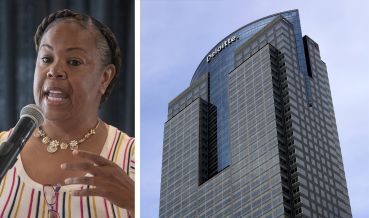No More Mr. Nice Guy: Is Forbearance Fatigue Starting to Set In?
By Mack Burke and Cathy Cunningham June 2, 2020 5:00 pm
reprints
A silver lining of the coronavirus pandemic has been watching a new dynamic unfold in the lender-borrower relationship; it’s a gentler, more compassionate one compared with past crises.
Unlike the finger pointing during the global financial crisis, both sides have quickly agreed that nobody is at fault in the current crisis. It wasn’t caused by greed, financial engineering, a lack of regulation, poor underwriting or borrower fraud. Everybody knows someone whose health has been affected by this crisis, and everyone in the industry was simultaneously caught off guard.
“[COVID-19] snuck up and crushed us into a brand new global financial crisis in the space of three weeks,” one alternative lender said. “Now everyone has to try to work together to get to the other side.”
As the virus began to spread, many landlords quickly realized they wouldn’t necessarily be receiving rent payments in April, or May, or maybe even in June.
The wave of borrower relief requests began in March, with lenders who spoke with Commercial Observer recounting incoming calls that varied from “Hi, just checking in with you,” to, “I want 18 months of forbearance and to use all of the reserves.” (That particular borrower was met with a pretty swift click of the phone hanging up.)
“Did some people start off asking for the moon? Sure,” the alternative lender said. “There were some people who did drive-bys to see if free lunches were being handed out when their cupboards were full and there was plenty of food in the fridge. It was pretty easy to say no to them.”
While 18 months was never gonna fly, a moderate three months’ forbearance became a common arrangement between lender and borrower. But as we enter the next three months of a market struggling to find its feet and time runs out on previous forbearances, is lender patience now starting to wear thin?
“Forbearance fatigue is what you’re seeing start to appear,” said JCR Capital co-founder and managing principal Jay Rollins. “How [lenders] pick and choose who gets the next round [of relief] and who gets it now is going to be very specific. I don’t think there are a lot of people with cash-flowing properties at 1.25x DSCR that are asking for relief. There’s always a few who are cranking cash flow and asking for it, and if they are, they shouldn’t get relief. It’s a tough conversation, it will get tougher come the next 90 days and that conversation’s going to be asset class by asset class.”
Given the uncertainty across the country around a reopening, Rollins added, there’s going to be a “real heavy second and third round of forbearances. Lenders are starting to separate the herd. When are lenders going to say no to properties that can’t cover [debt service]? That’s when the rubber hits the road and it’s going to shape the industry.”
More Than We Can Forebear
Lenders were pretty willing to grant forbearance of up to three months at first, said Warren de Haan, a co-founder of Acore Capital. He noted that even though the stock market has rebounded in the past three months, borrowers have not seen similar gains and aren’t in as good a position as that timeline draws to a close.
“If you look at where the stock market is trading today you’d think that everything is back to normal completely and there are no problems in the world,” he said. “But when you talk to folks on the ground on Main Street, we’re at record-level unemployment, there’s no cure for the virus. People are starting to open the economy — which is the right move I think — but it’s a question of whether the population can socially distance appropriately and keep the virus under control.”
In allowing three months’ forbearance, many lenders — conscious of the uncertainty of the virus’s timeline — worked out solutions that would stretch slightly further out.
“In an ideal world we’d like to fix [borrowers’ problems] for longer,” de Haan said. “We’re busy so we don’t want borrowers coming back to us all the time. So, we tried to do deals with borrowers where they’d put more cash in today and we’d give them six months of forbearance. That forbearance was in return for the borrower either paying the loan down a bit or putting sizable reserves up front.”
Other lenders employed a similar strategy.
“When we made a forbearance agreement for three months, we didn’t just solve for the three months,” said one lender at a REIT who spoke on the condition of anonymity. “We did lots of cash flow projections with the sponsors, lots of assumptions on what occupancy levels would look like, how quickly they would ramp up and expected cash flows. We gave them forbearance on their interest and accrued it for a period of time. We also gave them relief on FF&E reserves. Some of these sponsors were able to borrow under PPP programs and others had working capital in their deal when the shit hit the fan. So, when we did these short-term forbearance agreements, it was based upon a lot of analysis in terms of what their need was projected to be over the next nine to twelve months — so, how do they play through this.”
“We don’t look at this as just a three month commitment, we look at it as a lifelong commitment,” Michael Pop, a managing director at Basis Investment Group, said. “The data is showing positive trends that the majority of tenants have been paying rent in April and May.”
Consumers are, of course, the first link in the payment daisy chain, with money moving from the consumer to the tenant to the landlord to the lender, and consumer activity determines what we may see in terms of the next round of relief requests, de Haan said: “That could drive some positive economic numbers. But I think it’s unlikely that we see enough economic activity to get properties to break even. I think there’s a far greater chance that borrowers will need an extension or modification of their forbearance, or something along those lines.”
Pay Attention to the Big Lenders Behind the Curtain
That daisy chain extends even further out to the warehouse or repo lenders that finance lenders’ activities. Those providers of liquidity have their own strings to pull when borrowers seek relief.
“It’s kind of three-dimensional in a sense with some finance companies because they’ve typically levered themselves,” Dustin Stolly, co-head of Newmark Knight Frank’s debt and structured finance practice said. “It’s not a one-to-one discussion but a one-to-two discussion, so a lot of those decisions will be driven by more than one party.”
“Warehouse lenders and finance companies will drive a lot of decisions and the unknown is how warehouse lenders will react to that second forbearance,” another advisory source, who requested anonymity, said. “If they require a paydown of warehouse facilities, are finance companies collateralized enough to do that? If not, there will be for-sale situations — loan sales. Obviously, most of the stress right now is in the hospitality and retail world. We’re seeing it leak into other asset classes, like offices that may have a smaller tenant base and collections from smaller tenants are far less than an institutional office with larger tenants or offices where institutional money may have reached for yield.”
The advisory source added: “as part of the diligence that rescue capital was performing on the likes of Ladder [Capital] and [TPG Real Estate Finance Trust], those specific investors were obviously in dialogue with those lenders to those specific organizations and the consensus I heard was that warehouse lenders were not going to be as flexible in the latter half of the year when performance data came back on riskier assets that were going to require more remargining. Most of these finance companies re-margined over the last few weeks, but there will be more margin calls as forbearance ends.”
On Friday, TPG REIT announced that Starwood Capital Group had stepped in to recapitalize it following severe liquidity issues and three months of margin calls. TPG will receive up to $325 million of capital from Starwood, with proceeds being used in part to deleverage TPG’s secured financing facilities.
Most of the non-bank lenders reliant on warehouse lines are doing fairly short restructures of the loan where there’s some level of interest forbearance that accrues, said the lender at the REIT. In return, the lenders are asking for equity going into the loan, or guarantees, or both.
“The important thing is it’s not going to be portfolio-wide [distress] for everybody, and so as a result, the people that lend to us are going to be looking at it as a broader picture, and we’re also looking at it as a broader picture,” the lender said. “It’s not like the entire loan book is under duress.”
Indeed, “if the borrower continues to put equity in, we’re going to be more inclined to help them if we feel there is value in the property,” the alternative lender said.
A Deal Is a Deal
“On the CMBS side, there are definitely people coming in reaching,” said Manus Clancy, a senior managing director and leader of applied data, research, and pricing at research firm Trepp. “[You might have an] office guy with a good tenant base and tenants paying at a fairly high level say, ‘Why not? If everyone’s getting relief, why shouldn’t I?’ Servicers are shutting that down. Servicers are taking in each one separately and looking at the merits, not giving any away and trying to make a good decision as their inboxes pile up. [They’re working to] see these as they are: where forbearance is necessary and where it’s an opportunistic request. It’s a much different experience for them versus a bank or a non-bank, where they have more flexibility. Servicers in CMBS are beholden to certain rules and it’s not the same as a relationship loan from a bank where some latitude was given at the beginning and then patience is tested.”
De Haan said that at the end of the day, ACORE is in the business of making loans to borrowers and business plans it believes in, and its view of who the best possible owner and operator for those assets is hasn’t changed post-pandemic. “I can only think of maybe two situations in our entire portfolio where I can now say I can think of a better borrower for this property. But, besides that, we have the right borrower and operator and there are no bad actors tied to this health issue.”
As such, ACORE will continue to work with its borrowers, while also keeping in mind the bargain that was made when the loan documents were signed: You’ll pay us back, we’ll make interest and you’ll keep the upside.
“As long as borrowers are operating in the spirit of the relationship between borrower and a lender, you’ll see lenders reciprocate in any way they can and provide the forbearance to bridge this pandemic,” de Haan said. “That’s the outcome I’d expect to be the most prevalent. From there you’ve got significant variances that are driven by the borrower’s ability to continue to contribute equity to the deal.”
On the other hand, to the extent that borrowers don’t support their properties, lenders have now had ample time to think about foreclosing on properties, de Haan said. If things get squirrely, lenders will be forced into those tough decisions as well as — for example — participating in the equity in return for funding additional dollars.
“We certainly are looking at all different outcomes of deals; whether we might have to take them back, what we’d do with them if we took them back, what the rebound characteristics are on a property-by-property basis,” de Haan said. “We’re well prepared for any of these outcomes but it’s really going to be on a deal-by-deal and borrower-by-borrower basis. The overarching theme is we’re happy with the decisions we made, but now we need to see what the borrowers are capable of doing during the events that happen over the next three months. A lot of this is tied to the momentum that’s being created by re-opening the economy but it all depends on whether there’s a resurgence of the virus and — if there is — then all bets are off.”
Rescue Me
Just as troubled lenders are being recapitalized by willing peers, borrowers whose lenders aren’t playing nice with them may also find saviors in the form of other lenders willing to step in with rescue capital.
“We are looking at situations like that,” de Haan said. “We would actively lend into situations like that and we think that’s the next wave of originations.”
Ultimately, “the government is betting that their stimulus and moving at warp speed on a [COVID-19] therapeutic will outrun forbearances,” Rollins said, adding that there was a feeling early on that you’d be shamed by the government if you didn’t provide forbearances. “Eventually [lenders] will say enough’s enough. The ‘Mr. Nice Guy’ is going to fade, and if [a borrower is not impaired], [lenders will start] foreclosing or we’re selling your note, or whatever.”


